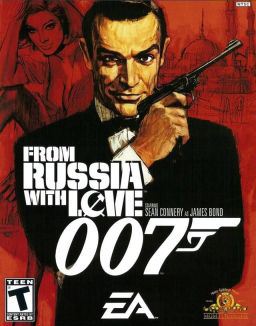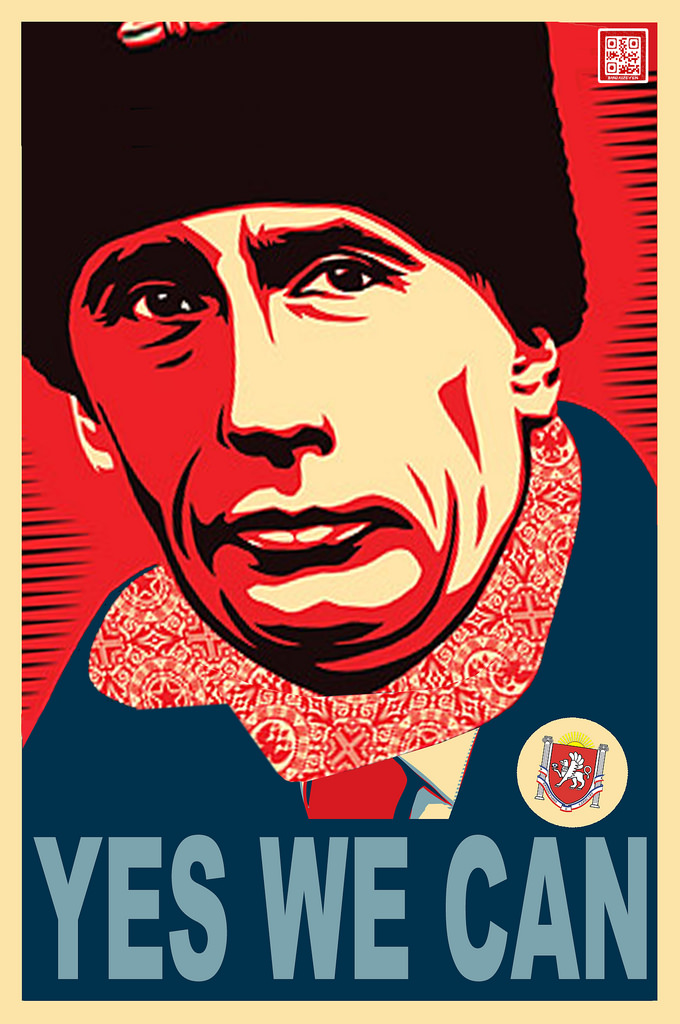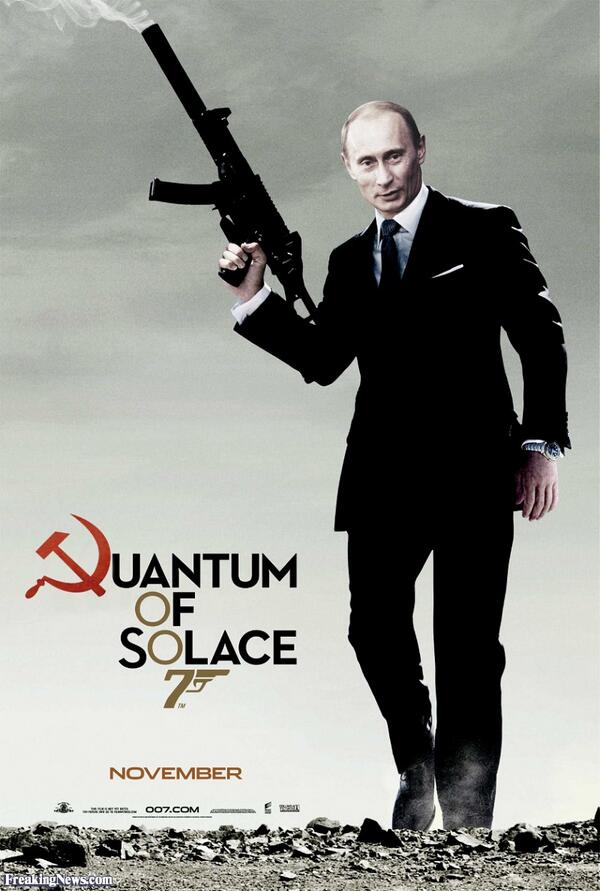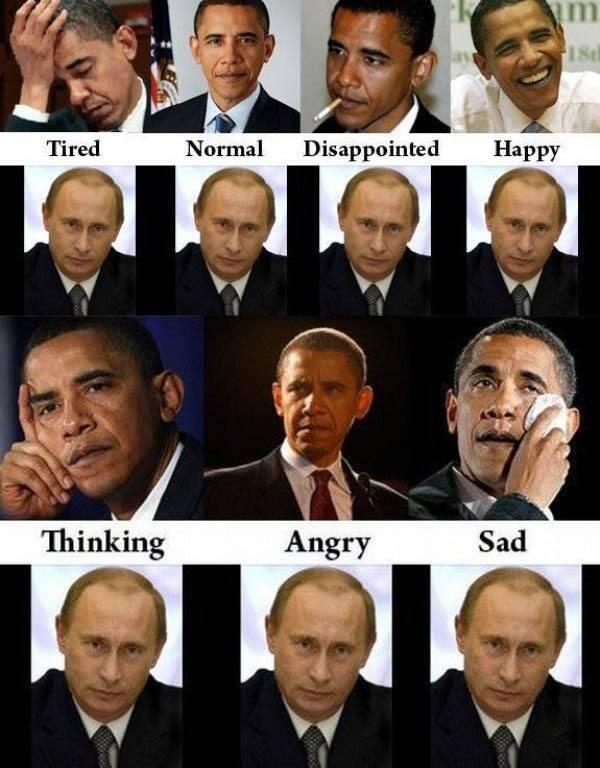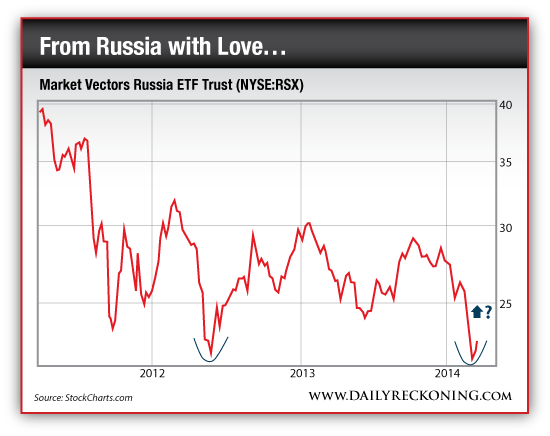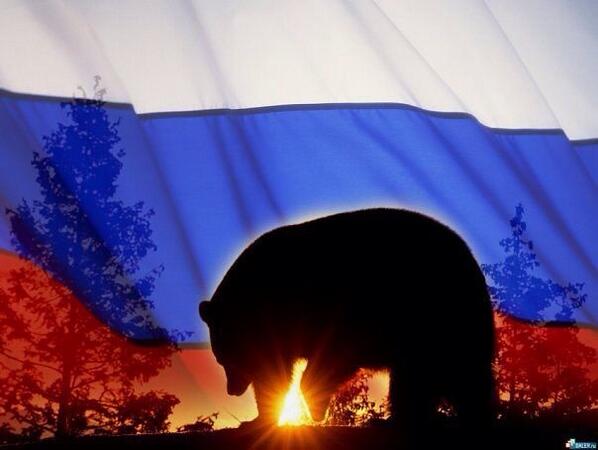From Russia with Love : How to Play Russia
April, 08 2014Aside from the historical importance of Crimea (Russia did fight France, England and Turkey 160 years ago to claim its stake on the Crimean peninsula), there are two potential reasons for Russia to risk everything in order to hold on to a warm seaport. Let us call the first explanation “reasoned paranoia,” the other “devilish Machiavellianism.”
Reasoned paranoia
Put yourself in Russian shoes for a brief instant: over the past two centuries, Russia has had to fight back invasions from France (led by Napoleon in 1812), an alliance including France, England and Turkey (Crimean War in the 1850s), and Germany in both world wars. Why does this matter? Because when one looks at a map of the world today, there really is only one empire that continues to gobble up territory all along its borders, insists on a common set of values with little discussion (removal of death penalty, acceptance of alternative lifestyles and multi- culturalism…), centralizes economic and political decisions away from local populations, etc. And that empire may be based in Brussels, but it is fundamentally run by Germans and Frenchmen (Belgians have a hard enough time running their own country). More importantly, that empire is coming ever closer to Russia’s borders.
Of course, the European Union’s enlargement on its own could be presented as primarily an economic enterprise, designed mainly to raise living standards in central and eastern Europe, and even to increase the potential of Russia’s neighbors as trading partners. However, this is not how most of the EU leaders themselves view the exercise; instead the EU project is defined as being first political, then economic. Worse yet in Russian eyes, the combination of the EU and NATO expansion, which is what we have broadly seen (with US recently sending fighter jets to Poland and a Baltic state) is a very different proposition, for there is nothing economic about NATO enlargement!
For Russia, how can the EU-NATO continuous eastward expansion not be seen as an unstoppable politico-military juggernaut, advancing relentlessly towards Russia’s borders and swallowing up all intervening countries, with the unique and critical exception of Russia itself ?
From Moscow, this eastward expansion can become hard to distinguish from previous encroachments by French and German leaders whose intentions may have been less benign than those of the present Western leaders, but whose supposedly “civilizing” missions were just as strong. Throw on top of that the debate/bashing of Russia over gay rights, the less than favorable coverage of its very expensive Olympic party, the glorification in the Western media of Pussy Riot, the confiscation of Russian assets in Cyprus … and one can see why Russia may feel a little paranoid today when it comes to the EU. The Russians can probably relate to Joseph Heller’s line from Catch-22: “Just because you’re paranoid doesn’t mean they aren’t after you.”
Devilish Machiavellianism
Moving away from Russia’s paranoia and returning to Russia’s permanent interests, we should probably remind ourselves of the following when looking at recent developments:
- Vladimir Putin is an ex-KGB officer and deeply nationalistic,
- Putin is very aware of Russia’s long-term interests, 3) when the oil price is high, Russia is strong; when the oil price is weak, Russia is weak.
It is perhaps this latter point that matters the most for, away from newspapers headlines and the daily grind of most of our readers, World War IV has already started in earnest (if we assume that the Cold War was World War III). And the reason few of us have noticed that World War IV has started is that this war pits the Sunnis against the Shias, and most of our readers are neither. Of course, the reason we should care (beyond the harrowing tales of human suffering coming in the conflicted areas), and the reason that Russia has a particular bone in this fight, is obvious enough: oil.
Indeed, in the Sunni-Shia fight that we see today in Syria, Lebanon, Iraq and elsewhere, the Sunnis control the purse strings (thanks mostly to the Saudi and Kuwaiti oil fields) while the Shias control the population. And this is where things get potentially interesting for Russia. Indeed, a quick look at a map of the Middle East shows that a) the Saudi oil fields are sitting primarily in areas populated by the minority Shias, who have seen very little, if any, of the benefits of the exploitation of oil and b) the same can be said of Bahrain, where the population is majority Shia.
Now of course, Iran has for decades tried to infiltrate/destabilize Shia Bahrain and the Shia parts of Saudi Arabia, though so far, the Saudis (thanks in part to US military technology) have done a very decent job of holding their own backyard. But could this change over the coming years? Could the civil war currently tearing apart large sections of the Middle East get worse?
At the very least, Putin has to plan for such a possibility which, let’s face it, would very much play to Russia’s long-term interests. Indeed, a greater clash between Iran and Saudi Arabia would probably see oil rise to US$200/barrel. Europe, as well as China and Japan, would become even more dependent on Russian energy exports. In both financial terms and geo-political terms, this would be a terrific outcome for Russia.
It would be such a good outcome that the temptation to keep things going (through weapon sales) would be overwhelming. This is all the more so since the Sunnis in the Middle East have really been no friends to the Russians, financing the rebellions in Chechnya, Dagestan, etc. So having the opportunity to say “payback’s a bitch” must be tempting for Putin who, from Assad to the Iranians, is clearly throwing Russia’s lot in with the Shias.
Of course, for Russia to be relevant, and hope to influence the Sunni-Shia conflict, Russia needs to have the ability to sell, and deliver weapons. And for that, one needs ships and a port. Ergo, the importance of Sevastopol, and the importance of Russia’s Syrian port (Tartus, sitting pretty much across from Cyprus).
The questions raised
The above brings us to the current Western perception of the Ukrainian crisis. Most of the people we speak to see the crisis as troublesome because it may lead to restlessness amongst the Russian minorities scattered across Eastern Europe and Central Asia, and tempt further border encroachments across a region that remains highly unstable. This is of course a perfectly valid fear, though it must be noted that, throughout history, there have been few constants to the inhabitants of the Kremlin (or of the Winter Palace before then). But nonetheless, one could count on Russia’s elite to:
- Care deeply about maintaining access to warm-water seaports and
- Care little for the welfare of the average Russian
So, it therefore seems likely that the fact that Russia is eager to redraw the borders around Crimea has more to do with the former than the latter. And that the Crimean incident does not mean that Putin will try and absorb Russian minorities into a “Greater Russia” wherever those minorities may be. The bigger question is that having secured Russia’s access to Sevastopol, and Tartus, will Russia use these ports to influence the Shia-Sunni conflict directly, and the oil price indirectly?
After all, with oil production in the US re-accelerating, with Iran potentially foregoing its membership in the “Axis of Evil,” with GDP growth slowing dramatically in emerging markets, with either Libya or Iraq potentially coming back on stream at some point in the future, with Japan set to restart its nukes … the logical destination for oil prices would be to follow most other commodities and head lower. But that would not be in the Russian interest for the one lesson Putin most certainly drew from the late 1990s was that a high oil price equates to a strong Russia, and vice-versa.
And so, with President Obama attempting to redefine the US role in the region away from being the Sunnis’ protector, and mend fences with Shias, Russia may be seeing an opportunity to influence events in the Middle East more than she has done in the past. In that regard, the Crimean annexation may announce the next wave of Sunni-Shia conflict in the Middle East, and the next wave of orders for French-manufactured weapons (as the US has broadly started to disengage itself, France has been the only G8 country basically stepping up to fight in the Saudi corner … a stance that should soon be rewarded with a €2.7bn contract for Crotale missiles produced by Thales and a €2.4bn contract for Airbus to undertake Saudi’s border surveillance). And, finally, the Crimean annexation may announce the next gap higher in oil prices.
In short, buying a straddle option position on oil makes a lot of sense. On the one hand, if the Saudis and the US want to punish Russia for its destabilizing actions, then the way to do it will be to join forces (even if Saudi-US relations are at a nadir right now) and crush the oil price. Alternatively, if the US leadership remains haphazard and continues to broadly disengage from the greater Middle East, then Russia will advance, provide weapons and intelligence to the Shias, and the unfolding Sunni- Shia war will accelerate, potentially leading to a gap higher in oil prices.
One scenario is very bullish for risk assets, the other is very bearish! Investors who believe that the US State Department has the situation under control should plan for the former. Investors who fear that Putin’s Machiavellianism will carry the day should plan for the latter (e.g., buy out-of-the-money calls on oil, French defense stocks, Russian oil stocks).
How to play russia
While the Russians goose step across Crimea, President Obama may have just unleashed a secret buy signal for Russian stocks… “I wouldn’t, if I were you, invest in Russian equities right now… unless you’re going short.” by the White House press secretary– who is apparently moonlighting as a financial advisor.
I immediately pulled up my charts. Could Russia actually turn into the market’s ultimate contrarian play?
The Crimean crisis has made Russian equities dirt cheap by any standard, Noah reports. The MICEX Index, which tracks the 50 largest and most liquid Russian stocks, carries a trailing P/E ratio of just 4.30. All of the other big Russian ETF’s hover in the same range, too. Compare that to the trailing P/E’s of other arguably “cheap” emerging market ETFs. China clocks in with a P/E of 9.39. Brazil sits at 11.72. Even India stands at 15.49.But what’s really interesting about the Russia situation is the chart…
ere we have a potential bottom in the works. During the height of the crisis, the Market Vectors Russia ETF Trust (NYSE:RSX) briefly dipped under its 2012 lows. However, Russian stocks have made a sharp recovery over the past weeks.
So we have a play here that’s cheap and has an intriguing chart. Of course, I have no idea how the Crimea situation will play out. The region will likely remain highly volatile for some time…
But right now, you have the opportunity to take a swing at Russian stocks with RSX. A snapback rally could ignite shares and give you the chance to book quick gains. Just set you stops at this month’s lows and let the position work for you.
If you have a plan like this in place, you can buy the blood in the streets without an insane amount of risk…
Please do not take this as trading advice. I am neutral on Russian equities – and personally, do better with bonds. So just for information, and a contrarian Western view
3 Russian Stocks Poised to Double or Triple
Even though the MSCI Russia index has surged 13.4% since mid-March, compared with a 2.6% rise for MSCI USA, Russian shares remain dirt cheap : three blue chips that could double or triple within five years.
Why the recent rally? First, there were three years of underperformance, punctuated by a three-week plunge starting late February when Russia began taking steps toward its takeover of Ukraine’s Crimean peninsula. Second, the economic blowback of that invasion for Russia looks limited to a round of halfhearted sanctions from the U.S. and Europe, so investors are moving back in.
Past the headline risk and focus on valuations. We figure we need about a 50% discount to get us interested in Russia. But we’re getting an 80% to 90% discount.
MSCI Russia has lost 15.4% a year over the past three years, versus a 13.4% yearly gain for its U.S. counterpart. The RTS index of the 50 most liquid Moscow shares recently traded at 4.8 times this year’s earnings forecasts and carried a 4.9% dividend yield, according to FactSet. That compares with 15.9 times earnings and a 2% yield for the Standard & Poor’s 500 index of large U.S. companies.
Take oil and gas giant GAZPROM ticker: OGZPY), which has the top weighting in the RTS index. It trades at just 2.8 times this year’s earnings estimates and yields 4.5%. Barron’s wrote this past week about the possibility of a sharp drop in oil prices
Let’s say that Gazprom’s valuation offsets the risk, and then some. By his math, Gazprom’s price implies a value of just $1.10 for each proven barrel of oil equivalent (a catch-all measure of crude and gas quantities) in reserve. That compares with $17.71 forExxon Mobile XOM), $19.73 for Royad Dutch Shell (RDSA) and $14.17 for PetroChina (PTR).
Gazprom, which had to foot part of the bill for theWinter Olympics in Sochi, expects to pay six to eight rubles per share in dividends this year, implying a yield of 4.5% to 6%. A tripling of the stock price in three years wouldn’t be outlandish, says Iben.
Second is SBERBANK (SBRCY), which has the second-largest weight in the RTS index. It sells for 0.8 times this year’s estimated book value of its assets, roughly in line with major U.S. banks. But the growth prospects are better: “Russia’s economy isn’t over-levered, so banks can grow loans at double digit rates for years to come,” he says. “U.S banks are struggling to grow loans at all.” Sberbank has a dividend yield of just over 3%. Shares could double over five years.
Third RusHydro (RSHYY), which generates electric power, ranks in the middle by weighting in the RTS index. It trades at 6.2 times earnings and yields 1.7%. Iben calculates that the company’s stock market value implies a price of about $300 for each kilowatt-hour of generation capacity it owns. The replacement cost is $2,000 per kwh, and Idacorp IDA), a hydropower company based in Idaho, is valued at about $3,000 per kwh of capacity. Shares of RusHydro could triple in price over five years, says Iben. Estimates compiled by FactSet show earnings per share rising from nine rubles this year to 13 rubles in 2016 — a 44% rise over two years.
As for the macro risks facing Russia, we should not be overly concerned about currency movements, pointing to last year, when currencies in Turkey and Japan both dropped, but Japan shares soared in dollar terms while Turkish shares fell. Asked about the possibility of the Russian government getting grabby with private business, he says that’s going to happen around the world anyway through taxes, because Western governments need funds. At least Russia is running a balanced budget.



